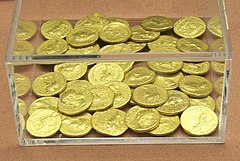
The Bredgar Hoard is a Roman coin hoard found in Bredgar, Kent in 1957. It consisted of 34 gold aurei, the latest of which were from 41 to 42 AD.[1] The coins are in the British Museum.[2]
The hoard was discovered by Bryan Hollands, who was digging foundations for his bungalow in Gore Road, Bredgar. The coins consisted of one Julius Caesar, twelve Augustus, seventeen Tiberius, one Nero Drusus, and three Claudius aurei.[3] The coins were buried in about 43 AD, the year of the Roman invasion of Britain.[4] It may have represented the savings of a Roman officer who was killed in the Battle of the Medway.[5]
References
[edit]- ^ Carson, R. A. G. (1957). "The Bredgar Treasure of Roman Coins". The Numismatic Chronicle. 9: 17–22. JSTOR 42662357. Retrieved 9 September 2022.
- ^ "Coin: 1957,1010.31". British Museum. Retrieved 9 September 2022.
- ^ "Monument details". Kent County Council. 25 January 2008. Retrieved 9 September 2022.
- ^ "Hoards and hoarding". Current Archaeology. 1 October 2010. Retrieved 9 September 2022.
- ^ Hunter, Chris (30 November 2020). "Tales of trash and treasure on the never-ending quest of Kent metal detectorist". Kent Online. Retrieved 9 September 2022.

Well, that’s interesting to know that Psilotum nudum are known as whisk ferns. Psilotum nudum is the commoner species of the two. While the P. flaccidum is a rare species and is found in the tropical islands. Both the species are usually epiphytic in habit and grow upon tree ferns. These species may also be terrestrial and grow in humus or in the crevices of the rocks.
View the detailed Guide of Psilotum nudum: Detailed Study Of Psilotum Nudum (Whisk Fern), Classification, Anatomy, Reproduction